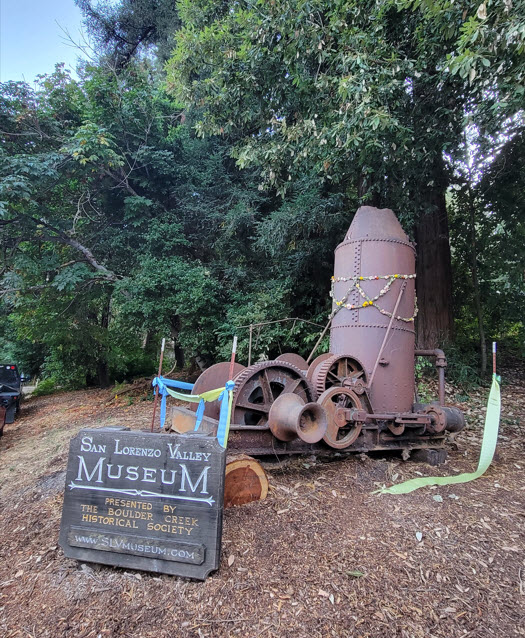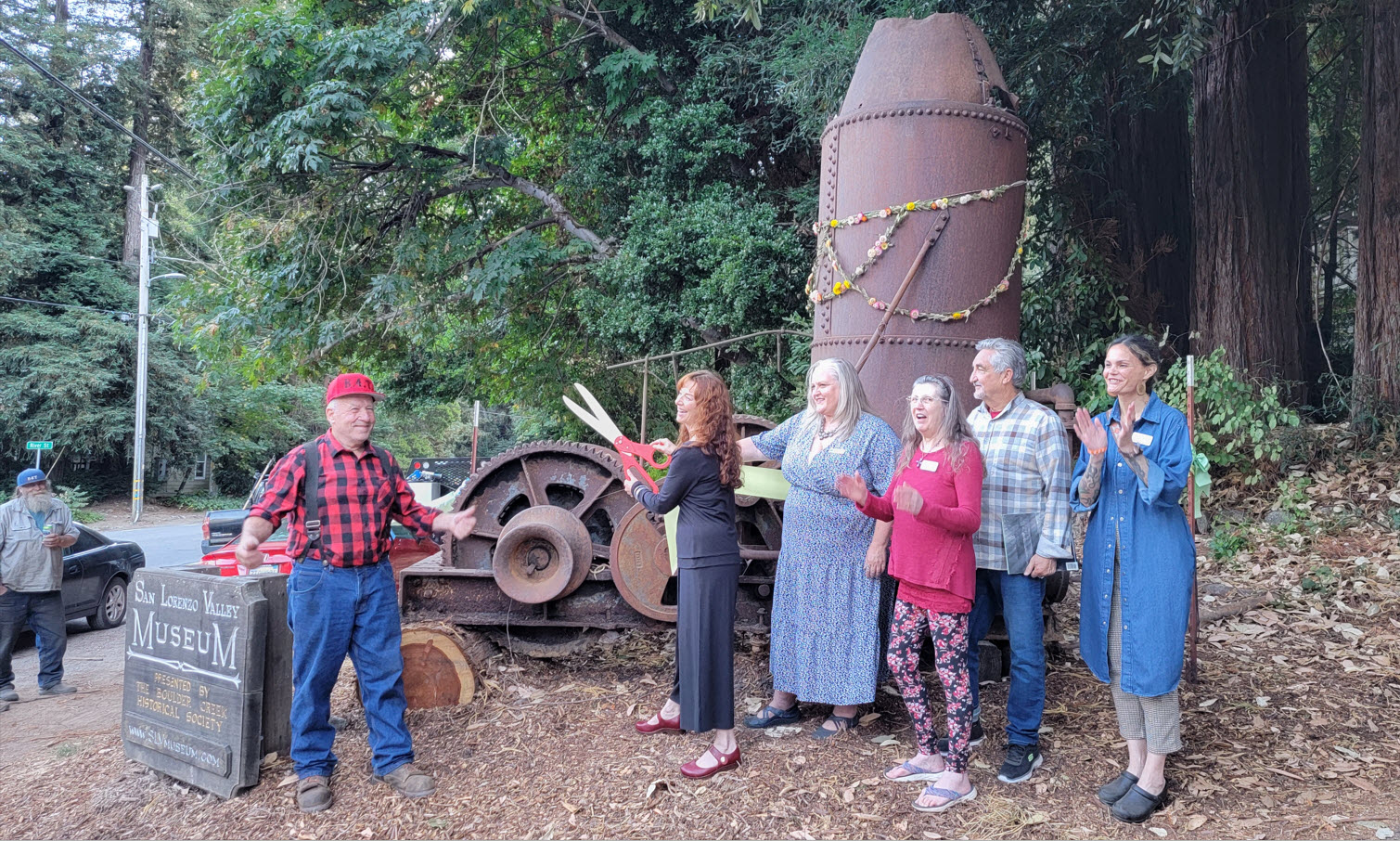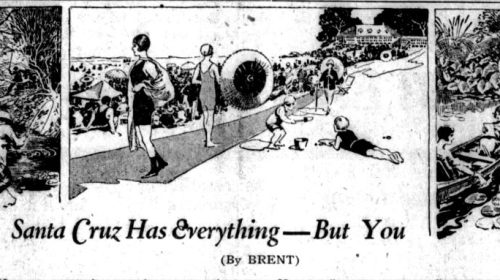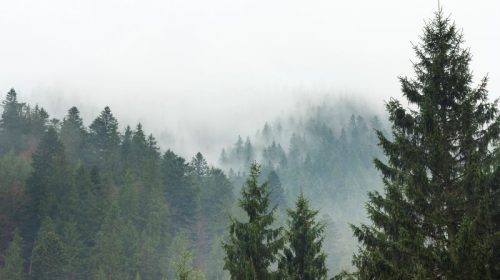Historic Steam Donkey Installation Ceremony
Tree Faller Bruce Baker and San Lorenzo Valley Museum Director Lisa Robinson celebrate receipt of a steam donkey logging era artifact at the museum in Boulder Creek, California.
By Julie Horner
On Friday, September 1, 2023, the San Lorenzo Valley Museum officially celebrated the receipt of a steam-powered timber industry winch called a “steam donkey.” The late 1800s/early 1900s logging era artifact was retrieved from land owned by Allan Hicks in the Santa Cruz Mountains near the Gazos Creek Watershed and delivered to the entrance of the San Lorenzo Valley Museum Grace Episcopal Gallery, 12547 Highway 9, Boulder Creek, California on Friday, June 23, 2023. According to museum director Lisa Robinson, the steam donkey was manufactured by Thomas G. Cantrell and Leon C. Marchutz at the National Iron Works Factory of San Francisco.
The artifact was retrieved from the Santa Cruz Mountains by a team led by Baker that included members of E Clampus Vitus (ECV) Branciforte 1797 and the logistics professionals at Auto Care Towing.
Boulder Creek resident Alison Steele opened the festivities with a solo performance on the clawhammer banjo. SLV Museum Executive Director Laura DeAngelis addressed the gathering of 80 or so community members with a Native Land Acknowledgement. She said, “The Grace Episcopal Gallery and the Belardi Memorial Building are located on the unceded ancestral lands of the Awaswas speaking people and are part of the traditional territory of today’s Amah Mutsun Tribal Band.”
DeAngelis was followed by Museum Director Lisa Robinson, who gave an oral history of the steam donkey and how it was acquired by the Museum.
Remarks from Museum Director Lisa Robinson
“I want to thank those people who have donated to the steam donkey relocation fund. I want to say an especial thank you to Allan Hicks, who donated the steam donkey to the Museum through the Ainsley Forest LLC. I can’t tell you what it means for our community to have this wonderful artifact up front here.
Bruce Baker initiated this current ‘let’s get the donkey here’ effort. [This effort was] actually initiated in 2004. Thanks to those who participated in the relocation; Charlie Brown. And Julie Horner who documented that process. And Kimberle Baker for putting up with all of this. Everybody has played such an important role, it’s really wonderful. I also want to thank all of our members of the Museum. And volunteers. Thank you all so much.
Now, today is a very special day. And I know that some of you are looking at the steam donkey and saying, ‘Why didn’t you pressure wash it, why is it so dirty?’ Well, we don’t pressure wash artifacts, first off. And secondly, believe it or not, that dirt that is there is actually protecting some of the material that’s under it. And until we’ve decided what stabilization process we’re going to be using, and there are lots of different ways you can do this, but we have to take into account that it’s outdoors. We’re not going to wash that dirt off, we’re not going to clean that dirt off because it’s actually protecting the donkey. That’s why you see it still a little muddy, and quite honestly, some of that mud is probably adhered to some grease, which is also protecting it, and probably some oil, we don’t know. So that’s why we have not pressure-washed the donkey. But please know that the funds that have been raised for the steam donkey will be used for that very purpose. We also will be putting the smokestack back on top in the most appropriate way we can. We need to bear in mind that we have to find an adhering process that is honest to the steam donkey and doesn’t compromise the material.
You will note that the smokestack, which is off to the side of the steam donkey, has a lot of little dents in it. Yes, they are bullet holes. Somebody had used it for target practice at some point, unfortunately. The other thing that was very interesting when we recovered this steam donkey, was that there was a lot of very bright, white metal melted underneath it. This steam donkey has seen not one, but two forest fires. One in 1917, which actually started at the lumber mill, and of course the CZU fire. We don’t know when the bearings, which is what this white metal likely was underneath it, we don’t know when that melted, so the gears do not have any bearings — probably the CZU fire because that burned so hot.”
At the back of the Grace Gallery, there are exhibit boards that talk about the steam donkey. We were so lucky that people loved working in the Gazos Creek area, and we have two extensive oral histories that talk about the Campbell Redwood Lumber Company at the time when that area was being logged 1916 to 1918. They wrote two books, along with photographs of their experiences, and we were able to draw from that history of the steam donkey. That’s really rare, so we’re very very lucky.
I want you to really enjoy the fact that it’s got this grand spot on Highway 9 and is visible as you drive by. We will be using some of the funds to put permanent interpretive signage at the donkey. Will we put it on skids? It’s not clear. We have the skid ties, it was on skids. It’s possible that we might reconstruct them for the donkey. Will we ever fire this donkey? No. The donkey is not fireable. In fact, it probably wasn’t fireable in 1916 because there wasn’t a certification process in California at that time. Oregon, yes. Washington, yes. But California didn’t start certifying the boilers until much later, I think it was 1923. So today, there are very strict rules about steam boilers and meeting compliance, and this is an artifact, an artifact to be looked at, to be admired, and it’s true, it’s ‘as it was,’ no modifications. We want to keep it that way.”
Community Recognition
Executive Director Laura DeAngelis then presented Allan Hicks and Bruce Baker with Individual Lifetime Memberships for their contributions to the museum. To Allan Hicks she said, “It is through your generous donation that we are able to share and preserve this local logging artifact for future generations to come. On behalf of the San Lorenzo Valley Museum, I am honored to present you with an Individual Lifetime Membership.”
Tree faller Bruce Baker was honored next. “Bruce, it has been an absolute pleasure to get to know you and learn through your leadership in this tremendous endeavor. From the start, I was inspired by your passion to achieve the goal of relocating the steam donkey to our museum in Boulder Creek. In a matter of weeks, you managed to build a community of experts and supporters to facilitate the donation and relocation of this historic logging artifact. We are grateful for the privilege to share, preserve, and interpret this local history for future generations. On behalf of the San Lorenzo Valley Museum, I am honored to present you with an Individual Lifetime Membership.”
Bruce Baker addressed the crowd to thank some of his own team who were instrumental in the move. He began by saying, “I have so much to say and I want to call every one of you out, but I’m not going to. I’m humbled that I have this opportunity, but it’s all of you people who have made this happen for me. I did this for this community that I love, and the timber industry.” Baker called attention to fellow E. Clampus Vitus members Ben Unger and Charlie Brown. Brown was part of the team that moved the steam donkey. Bruce said, “Charlie Brown contacted Auto Care Towing, they’re the ones that actually did the physical move with Charlie Brown the mover. He’s our local mover. You want a piano in a bell tower? That’s our guy, right there.”
The event concluded with a ribbon cutting carried out by Boulder Creek Business Association Vice President Tamara O’Kelly.

Special Notes
The ribbon used for the ceremony was at least 60 years old, according to Lisa Robinson. And the garland of flowers adorning the steam donkey was made by professional flower arranger and Valley local Charina Makovsky.
Related story: https://slvpost.com/journey-through-time-historic-steam-donkey-steam-powered-winch-finds-new-home/
Watch the steam donkey being moved from the forest to the San Lorenzo Valley Museum on YouTube.
Photos by Julie Horner.
Julie Horner is Co-Founder and Editor for the San Lorenzo Valley Post. Julie lives and works in Boulder Creek and is an active participant in the county's vibrant music scene. She loves the outdoors and is the go-to expert on Santa Cruz Mountains hiking trails.





